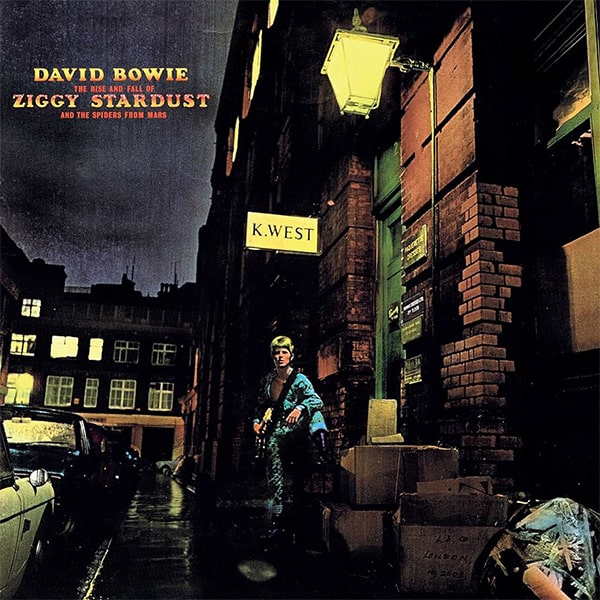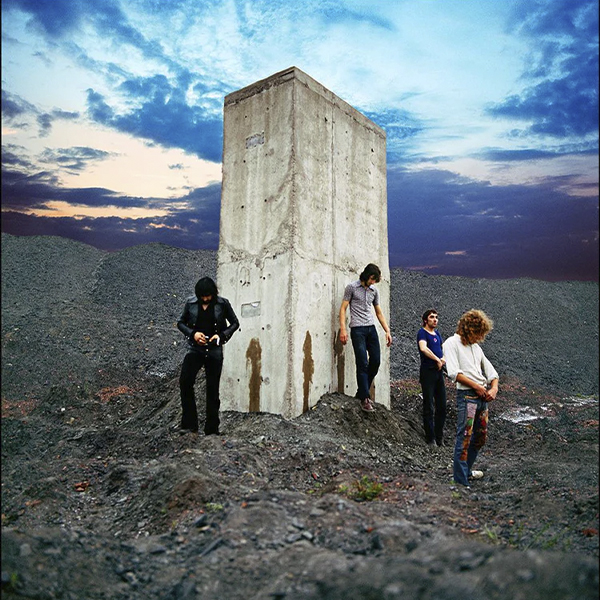- Last hi-fi news
- 0 likes
- 1111 views
- 0 comments

.
The 1970s was a golden age for rock music, marked by a huge diversity of sounds and styles, from hard rock and progressive to punk and folk. Focused on innovation and technology, this era produced some of the best sounding recordings in rock history. Here we look back at ten albums from the 1970s that stand out for their exceptional sound quality and influential production:
Pink Floyd - "The Dark Side of the Moon" (1973)
-1-min.jpg)
.
Pink Floyd's ‘The Dark Side of the Moon’, released in 1973, is considered one of the most important and influential albums in rock history. Its relevance in the 1970s and beyond can be understood from several perspectives:
The album is known for its advanced production and innovative use of sound effects, synthesizers and recording techniques. Alan Parsons, the sound engineer, played a crucial role in this.
It was one of the first albums to cohesively explore universal themes such as life, death, time, madness and conflict. Each song flows into the next, creating a continuous listening experience.
It made innovative use of stereo, which was advanced for the time and significantly enhanced the listening experience.
It became one of the best-selling albums of all time, remaining on the Billboard charts for over 900 consecutive weeks. It has sold more than 45 million copies worldwide.
It influenced countless subsequent musicians and bands, becoming a benchmark in music production and the creation of concept albums.
It touched on themes that resonated deeply with the generation of the time, dealing with stress, alienation, war and other social problems, offering a reflection on the human condition.
The album cover, designed by Storm Thorgerson and Aubrey Powell of Hipgnosis, features a prism refracting light, which has become an iconic image in popular culture.
Pink Floyd concerts during this era were known for their technical and visual complexity, with extensive use of lights, projections and special effects.
It represents a high point in Pink Floyd's career, consolidating their signature style that combines progressive rock with deep lyrics and atmospheric music.
It highlights the collaboration between the band members, especially Roger Waters, who wrote most of the lyrics, and David Gilmour, whose guitar and vocals are central to the album's sound.
This album is a masterpiece of production, notable for its pioneering use of analogue synthesisers, multi-track recording and audio effects. The sound quality is impeccable, with a rich, immersive experience that makes it a benchmark for audiophiles. Songs like ‘Time’ and ‘Money’ demonstrate a mastery of studio technology.
Led Zeppelin - "IV" (1971)
-1-min.jpg)
.
The album ‘Led Zeppelin IV’, released in 1971, is one of the most iconic and seminal rock albums, both in the 1970s and in the history of music in general.
The album features a wide range of musical styles, from hard rock and heavy metal to folk and blues. Songs like ‘Black Dog’ and ‘Rock and Roll’ exemplify hard rock, while ‘The Battle of Evermore’ and ‘Going to California’ show folk influences.
Produced by guitarist Jimmy Page, the album is notable for its innovative production. The use of advanced recording and mixing techniques contributed to a powerful and immersive sound.
Each band member (Jimmy Page, Robert Plant, John Paul Jones and John Bonham) brings an exceptional level of technical skill and creativity, which is reflected in the complexity and quality of the compositions.
‘Led Zeppelin IV has sold over 37 million copies worldwide, making it one of the best-selling albums of all time. Its commercial success helped establish Led Zeppelin as one of rock's greatest bands.
The album has influenced generations of musicians and bands. The complexity of the songs and instrumental mastery have become a standard to follow in rock and other genres.
‘Stairway to Heaven’: The album's most famous song, ‘Stairway to Heaven’ is considered one of the greatest rock songs of all time. Its progressive structure and iconic guitar solo have made it immortal in music culture.
The album cover, which contains neither the band's name nor the album title, was a bold decision that added an element of mystery and attracted attention. It features an image of an old man with a bundle of firewood on his back, contrasted with a modern cityscape on the inside.
Each band member selected a personal symbol to represent them on the inside of the album, adding an air of mystery and mysticism that has intrigued fans for decades.
‘Led Zeppelin IV represents the culmination of the style and sound that Led Zeppelin had been developing on their previous albums. It is a perfect combination of power, subtlety and complexity.
Despite initial mixed reviews, the album has been hailed over time as a masterpiece. It has been included in numerous lists of the greatest albums of all time and has received praise from critics and fans alike.
Fleetwood Mac - "Rumours" (1977)
-1-min.jpg)
.
Fleetwood Mac's album ‘Rumours’, released in 1977, is one of the most influential and successful albums of the 1970s and in the history of popular music.
‘Rumours’ is known for its distinctive sound combining rock, pop and folk. The harmonised vocals, melodic arrangements and polished production helped define the sound of the decade.
Produced by the band themselves along with Ken Caillat and Richard Dashut, the album employs advanced recording techniques for the time. Attention to detail in mixing and production contributed to a clear and dynamic sound.
‘Rumours’ has sold over 40 million copies worldwide, making it one of the best-selling albums of all time. It reached number one on the charts in several countries and won the Grammy Award for Album of the Year in 1978.
Songs from the album, such as ‘Go Your Own Way’, ‘Dreams’, ‘Don't Stop’ and ‘The Chain’, have become classics and remain popular on radio and streaming platforms. ‘Dreams’ resurfaced in popularity in 2020 thanks to a viral video on TikTok, demonstrating its continued relevance.
The cover, featuring Mick Fleetwood and Stevie Nicks in theatrical attire, is iconic and has been recognised for its distinctive style. The image complements the emotional and dramatic atmosphere of the album.
The band went on an extensive promotional tour that helped solidify their status as one of the top rock bands of the era. Live performances and interviews contributed to the album's mystique.
‘Rumours’ cemented Fleetwood Mac's signature sound and marked the high point of their career. The combination of Lindsey Buckingham, Stevie Nicks and Christine McVie's compositions resulted in a cohesive and emotionally resonant album.
The album was created in the midst of personal tensions and conflicts between the band members, which adds an additional layer of emotional depth to the songs. The lyrics reflect the challenges and rifts within the group, giving the album a raw authenticity.
‘Rumours has influenced countless artists and bands in the years since, especially in the rock and pop genres. Their focus on vocal harmonies and lyrical compositions has been emulated by many.
Over time, ‘Rumours’ has been hailed as one of the greatest albums of all time. It has appeared on numerous ‘best album’ lists and is studied for its excellence in songwriting and production.
David Bowie - "The Rise and Fall of Ziggy Stardust and the Spiders from Mars" (1972)

.
David Bowie's ‘The Rise and Fall of Ziggy Stardust and the Spiders from Mars’, released in 1972, is one of the most influential and iconic albums in rock history.
The album is a concept album that tells the story of Ziggy Stardust, a bisexual, androgynous alien who becomes a rock star. This narrative allowed Bowie to explore themes of identity, sexuality, and fame in a unique and artistic way.
The album combines rock, glam rock, and elements of theatrical music, creating a distinctive sound that defined 1970s glam rock. Songs like ‘Starman’ and ‘Suffragette City’ showcase this stylistic diversity.
Produced by Bowie and Ken Scott, the album uses advanced production techniques for the time, with a focus on creating an immersive, futuristic atmosphere.
‘Ziggy Stardust’ was a commercial success, reaching number 5 in the UK charts and greatly enhancing Bowie's visibility in the United States, where it also had a notable impact.
Since its release, the album has received critical acclaim and has been included in numerous lists of the greatest albums of all time. It is considered a masterpiece and a high point in Bowie's career.
The creation of the Ziggy Stardust character allowed Bowie to explore and challenge social norms about gender and sexuality, making him an icon of sexual liberation and individuality.
The Ziggy Stardust character was not only a musical figure, but also a visual and fashion phenomenon. Ziggy's flamboyant costumes, make-up and personality became an integral part of Bowie's show and identity.
The cover, photographed by Brian Ward, features Bowie as Ziggy on a London street, with an air of mystery and futurism that complements the album's music.
Bowie's live performances as Ziggy Stardust were theatrical and revolutionary, setting a new standard for rock concerts.
‘Ziggy Stardust marked a significant transformation in Bowie's career, cementing his reputation as a rock innovator and chameleon. It allowed Bowie to continually reinvent himself and explore new artistic directions.
The album's success elevated Bowie to international superstar status, opening doors for his future projects and cementing his legacy in music and pop culture.
The album has influenced countless artists and bands in a variety of genres. Its focus on theatricality, conceptual storytelling and exploration of themes of identity and sexuality has been emulated and paid homage to by many.
‘Ziggy Stardust’ remains relevant and popular, both for its music and its cultural impact. The album's songs continue to be performed and enjoyed by new generations of listeners.
Bowie's lyrics on ‘Ziggy Stardust’ explore themes of alienation, fame, decadence and apocalypse. The album's narrative provides a cohesive story that captures the listener's imagination and offers multiple layers of interpretation.
Bowie's music and performances as Ziggy Stardust have a theatrical quality that adds depth and dimension to the album experience, making each song and performance feel like part of a grand spectacle.
The Who - "Who's Next" (1971)

.
‘The Who's Next, released in 1971, is one of rock's most acclaimed albums.
The album is known for its innovative use of synthesizers, especially on songs like ‘Baba O'Riley’ and ‘Won't Get Fooled Again’. Pete Townshend used an ARP Synthesizer to create textures and sequences that were novel for the time and integrated perfectly with the rock.
Produced by Glyn Johns, ‘Who's Next’ is notable for its excellent production. The quality of the sound, the clarity of the instruments and the balanced mix contribute to the album's power.
Each band member (Pete Townshend, Roger Daltrey, John Entwistle and Keith Moon) contributes an exceptional level of technical skill. The guitar, bass, drums and vocal performances are outstanding and have been influential in the development of rock.
‘Who's Next’ was a commercial success, reaching number 4 on the Billboard charts in the US and number 1 on the UK charts. It has sold millions of copies worldwide.
Songs such as ‘Baba O'Riley’, ‘Behind Blue Eyes’ and ‘Won't Get Fooled Again’ have become rock classics. These songs remain popular on the radio and at concerts, and have influenced numerous later bands and artists.
Since its release, the album has been critically acclaimed and has been included in numerous lists of the greatest albums of all time. It is seen as a high point in the Who's career and a milestone in rock history.
The cover, which shows the band members after apparently having urinated on a monolithic structure, is iconic and provocative. It was photographed by Ethan Russell and has become a memorable image in rock culture.
The Who are known for their energetic and powerful live performances. The tours to promote ‘Who's Next’ cemented their reputation as one of the best live bands of the era.
‘Who's Next’ represents a point of maturity in the Who's career. After the successes of ‘Tommy’, this album showed an evolution in their sound and songwriting, with a more sophisticated and technical approach.
‘Lifehouse’: Originally, many of the songs on ‘Who's Next’ were to be part of an ambitious multimedia project called ‘Lifehouse’. Although ‘Lifehouse’ was never completed, the songs that survived and were included on ‘Who's Next’ reflect Townshend's ideas and creativity for that project.
‘Who's Next has influenced countless musicians and bands. Its combination of heavy rock, synthesizers and deep lyrics has been a role model for many artists.
The album continues to be studied and admired for its innovation and quality. It has maintained its relevance over the years, frequently appearing on lists of the best albums in history.
Eagles - "Hotel California" (1976)
-1-min.jpg)
.
Eagles' “Hotel California”, released in 1976, is one of the most iconic and successful albums.
Its importance can be understood from multiple perspectives:
The album fuses several musical genres, including rock, country rock and soft rock, creating a distinctive sound that defined an era.
The complex song structures and intricate instrumental arrangements are prominent throughout the album. The song ‘Hotel California’ is known for its acoustic intro, the transition into rock and the iconic guitar solo at the end.
Produced by Bill Szymczyk, the album features clean, detailed production that highlights the musical abilities of each band member.
‘Hotel California’ has sold over 32 million copies worldwide, making it one of the best-selling albums of all time. It reached #1 on the Billboard charts and has received multiple platinum albums.
The songs ‘Hotel California’, ‘New Kid in Town’ and ‘Life in the Fast Lane’ became instant classics. ‘Hotel California’ in particular, with its enigmatic lyrics and epic guitar solo, has become one of the most recognisable and beloved songs in rock history.
The album has been acclaimed by critics and fans alike. It has appeared on numerous lists of the greatest albums of all time and has won major awards, including a Grammy for ‘Hotel California’ as Record of the Year.
The album cover, depicting the Beverly Hills Hotel in California, was designed by John Kosh and photographed by David Alexander. The image has become iconic and reflects the glamour and decadence of life in California.
The album is known for exploring themes of decadence, hedonism and the dark side of the American dream. The poetic and enigmatic lyrics by Don Henley and Glenn Frey invite multiple interpretations and have generated debate and analysis over the years.
‘Hotel California’ represents the Eagles' creative and commercial peak. It cemented their status as one of the most important bands of the 1970s and defined their signature sound.
This album was the first with guitarist Joe Walsh, whose style significantly influenced the band's sound. His entrance brought a new energy and dimension to the compositions.
‘Hotel California’ has had a lasting impact on rock music and has influenced countless subsequent artists and bands. Its mix of genres and focus on lyrical storytelling set a standard for concept albums.
The song ‘Hotel California’ remains a constant radio presence and is a mainstay on classic rock playlists. The band has continued to perform songs from the album on tour, maintaining its relevance throughout the decades.
Queen - "A Night at the Opera" (1975)
-1-min.jpg)
Queen's ‘A Night at the Opera’, released in 1975, is one of the most important and innovative albums in rock history.
The album is known for its musical diversity, covering a wide range of genres, from rock and pop to opera and progressive music. Songs such as ‘Bohemian Rhapsody’, ‘Love of My Life’ and ‘The Prophet's Song’ showcase this versatility.
Produced by Roy Thomas Baker and Queen, the album used advanced production techniques for the time. This included multiple layers of vocals and instruments, as well as unique sound effects.
‘Bohemian Rhapsody’. This song, in particular, is famous for its unconventional structure, which includes a ballad introduction, an operatic guitar solo and a hard rock section. The song's complexity and creativity made it a milestone in music history.
‘A Night at the Opera’ was a massive commercial success, reaching number one on the UK album charts and number four on the US Billboard charts. It has sold over 6 million copies worldwide.
Success of ‘Bohemian Rhapsody’: The single ‘Bohemian Rhapsody’ became a global phenomenon, reaching number one in several countries. Its music video, one of the first of its kind, helped popularise the format and is considered a pioneer in the history of music videos.
The album, and ‘Bohemian Rhapsody’ in particular, have left an indelible mark on popular culture. The song has been reinterpreted and paid tribute to on numerous occasions, including its iconic use in the film ‘Wayne's World’.
The cover, designed by Freddie Mercury, features the Queen logo with the zodiac signs of the band members, reflecting the band's grandeur and distinctive style.
The video for ‘Bohemian Rhapsody’ is considered one of the first music videos and revolutionised the way music was presented visually. This visual approach helped define Queen's identity and set a new standard in the music industry.
‘A Night at the Opera’ cemented Queen's musical style and identity. It was a turning point in their career, showcasing their ability to combine theatricality, musical virtuosity and creativity into a cohesive work.
The album received praise from critics and fans alike, establishing Queen as one of the most innovative and beloved bands of the era.
The album has influenced numerous subsequent artists and bands, inspiring musicians in a variety of genres. The combination of rock with operatic and theatrical elements has been emulated but rarely equalled.
Songs from ‘A Night at the Opera’, especially ‘Bohemian Rhapsody’, are still popular today. The song has been re-released and has returned to the charts several times, maintaining its relevance through the decades.
Queen's willingness to experiment and break conventional rock boundaries set a new standard for what a rock album could be. This innovative and bold approach has been a role model for many subsequent artists.
The Rolling Stones - "Exile on Main St." (1972)
-1-min.jpg)
.
The Rolling Stones' “Exile on Main St.”, released in 1972, is widely considered one of the best and most influential rock albums of all time.
The album is an eclectic mix of rock, blues, country, soul and gospel. This fusion of genres shows the band's versatility and their ability to incorporate diverse influences into their music.
Recorded largely in the basement of a rented villa in the south of France, the album has a raw, unhurried sound. This less polished production gives it an authentic and honest character.
The improvised nature of the recording sessions allowed for a great deal of experimentation and collaboration. This resulted in an album that is both diverse and cohesive.
Despite its unconventional nature, ‘Exile on Main St.’ was a commercial success, reaching number one on the album charts in the US and UK. It has sold millions of copies worldwide.
Initially, reviews were mixed, but over time, the album has been re-evaluated and is now considered a masterpiece. It has appeared on numerous lists of the greatest albums of all time.
The album has been emblematic of the rock culture and counterculture of the time. It reflects the hedonistic lifestyle and atmosphere of excess that surrounded the band during its creation.
The cover, designed by photographer Robert Frank, features a collage of black and white images that reflect the diversity and chaos of the album. This cover has become iconic in rock culture.
Despite the lack of a dominant single prior to release, the album's promotion focused on its authenticity and the band's reputation as rock pioneers.
‘Exile on Main St.’ is often considered the high point of The Rolling Stones' career. It represents the culmination of their signature sound and their ability to reinvent themselves.
Recorded during a period of personal and professional tumult for the band, the album shows their ability to overcome difficulties and create lasting and meaningful music.
The influence of ‘Exile on Main St.’ can be heard in a wide variety of genres and in the work of many subsequent artists. His approach to genre blending and his production style have been especially influential.
Over the years, the album has been positively re-evaluated by critics and musicians alike, cementing its status as one of the best albums in rock history.
The band's willingness to experiment with different styles and their commitment to an authentic, carefree sound has been an inspiration to many artists.
Although the album is diverse in style, it maintains a cohesion that makes it a unified listening experience. The lyrics and themes reflect life on the road, hedonism and the search for redemption, universal themes that resonate deeply.
Bruce Springsteen - "Born to Run" (1975)
-1-min.jpg)
.
Bruce Springsteen's ‘Born to Run’, released in 1975, is one of the most influential and acclaimed albums in rock history.
The album is known for its ‘wall’ sound, influenced by Phil Spector's production, and its dense, grandiose arrangements. It combines rock, pop and soul with poetic and narrative lyrics.
Produced by Springsteen, Jon Landau and Mike Appel, ‘Born to Run’ employs advanced recording techniques for the time. The production is meticulous, seeking to create an epic and cinematic sonic experience.
The E Street Band, with members Clarence Clemons (saxophone), Roy Bittan (piano) and Max Weinberg (drums), provides a rich and diverse instrumentation that complements Springsteen's compositions.
‘Born to Run’ was a commercial success, reaching number 3 on the Billboard charts. Sales of the album catapulted Springsteen to fame, and it has sold millions of copies worldwide.
The songs ‘Born to Run’ and ‘Tenth Avenue Freeze-Out’ became huge hits and remain rock classics. ‘Born to Run’ is particularly known for its energy and its evocation of the desire to escape and seek freedom.
The album received critical acclaim since its release and has been repeatedly hailed as one of the greatest rock albums of all time. It was praised for its ambition, lyricism and emotional impact.
The album cover, featuring a black and white photograph of Springsteen leaning on saxophonist Clarence Clemons, is an iconic rock image. It was photographed by Eric Meola and reflects the camaraderie and energy of Springsteen's music.
Promotion of the album was intense, with Springsteen appearing on the covers of Time and Newsweek in the same week. This helped build buzz and solidify his public image.
‘Born to Run marked a turning point in Springsteen's career, consolidating his lyrical and musical style. It represents the culmination of his ability to tell stories through his songs and capture the essence of the American spirit.
The album elevated Springsteen to rock superstar status and earned him widespread critical and popular acclaim. This success laid the foundation for his future career.
‘Born to Run has influenced countless musicians and bands. Its combination of epic rock with introspective, narrative lyrics has been a role model for many subsequent artists.
Songs from the album remain popular on the radio and at Springsteen concerts. ‘Born to Run’ in particular, is an intergenerational anthem that continues to resonate with new audiences.
Springsteen's lyrics on Born to Run explore themes of youth, escape, love and struggle. The album's narrative reflects the desire to overcome limitations and find a sense of freedom and purpose.
The music and lyrics of ‘Born to Run’ have a cinematic quality, painting vivid images of life and dreams on the margins of American society. This ability to tell stories in such a visual and emotional way has been highly influential.
Neil Young - "Harvest" (1972)
-1-min.jpg)
.
Neil Young's ‘Harvest’, released in 1972, is one of the most iconic and influential albums of the 1970s.
‘Harvest’ combines elements of rock, folk, country and soft rock, creating a unique and accessible sound that appealed to a wide audience. Songs like ‘Heart of Gold’ and ‘Old Man’ showcase this fusion of styles.
The album was produced by Neil Young, Elliot Mazer, Henry Lewy and Jack Nitzsche. The production is simple and organic, highlighting the authenticity and focus on the lyrical and melodic compositions.
Some songs on the album, such as ‘A Man Needs a Maid’ and ‘There's a World’, feature orchestral arrangements composed by Jack Nitzsche, adding an extra dimension to Young's introspective ballads.
‘Harvest’ was a huge commercial success, reaching number one on the US Billboard album charts and being the best-selling album of 1972. ‘Heart of Gold’ became Young's only number one single in the United States.
Since its release, the album has been critically acclaimed and is considered one of Neil Young's best albums. It has been included in numerous lists of the greatest albums of all time.
The thoughtful lyrics and accessible music of ‘Harvest’ resonated deeply with audiences at the time, and the album has become a symbol of 70s music.
The cover, designed by Tom Wilkes, is simple but evocative, featuring an antique typeface and a design that reflects the pastoral and melancholic tone of the music.
‘Harvest’ cemented Neil Young's image as a reflective, solitary troubadour, a contrast to the harsher aesthetic of his rock contemporaries.
‘Harvest represented the high point of Young's commercial career, catapulting him to international stardom. It cemented his reputation as one of the most important songwriters and musicians of his generation.
The success of ‘Harvest’ allowed Young to continue exploring different musical directions in his career, from hard rock to introspective and experimental folk.
‘Harvest’ has influenced numerous artists in a variety of genres, including rock, country and folk. His focus on lyrical and melodic songwriting has been particularly influential.
Songs from ‘Harvest’ remain popular and are frequently performed in concert. ‘Heart of Gold’ and ‘Old Man’ in particular are considered timeless classics.
Young's lyrics on Harvest explore themes of love, loss, introspection and the search for meaning. The honesty and vulnerability in his lyrics have resonated deeply with listeners.
The simplicity and authenticity of the production and performances on ‘Harvest’ have been praised for their ability to connect emotionally with the audience, creating an intimate and meaningful listening experience.
Get 2 MONTHS FREE in Qobuz

Now, when you subscribe to our newsletter, you will receive a FREE two-month subscription to Qobuz, the premium music streaming platform.
Qobuz gives you unlimited access to a vast library of hi-fi music, perfect for audio enthusiasts looking for the best sound quality. Explore genres ranging from classics to the latest releases, and enjoy a superior listening experience.
How can you take advantage of this incredible offer? It's simple:
1. Visit our website.
2. Enter your email address to subscribe to our newsletter.
3. Receive your access code for two free months at Qobuz.
Don't miss this unique opportunity! Immerse yourself in the world of music with Qobuz and enjoy sound quality like never before. Subscribe today!

















































































































































Comments (0)